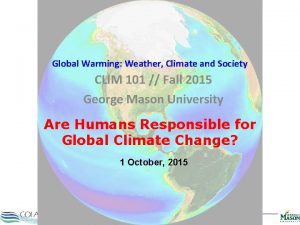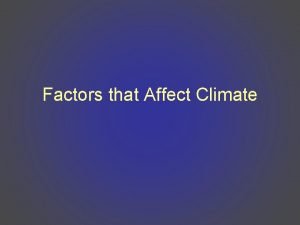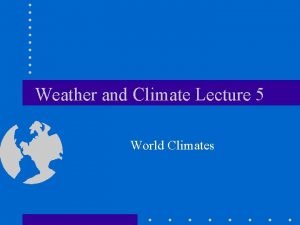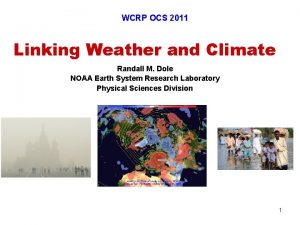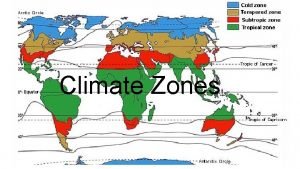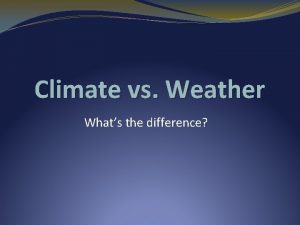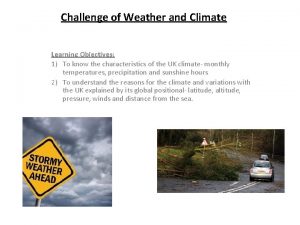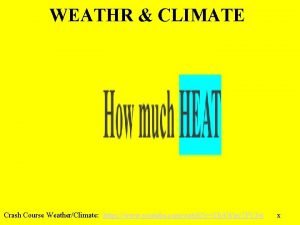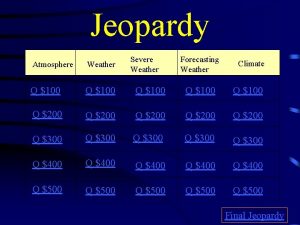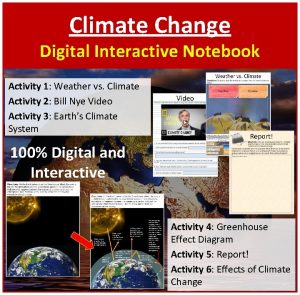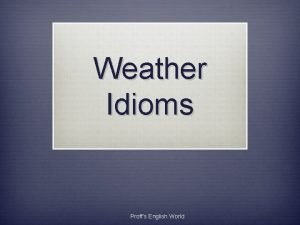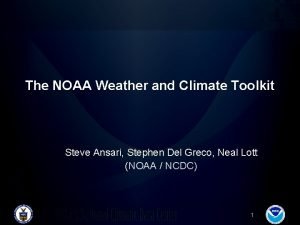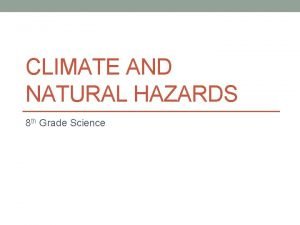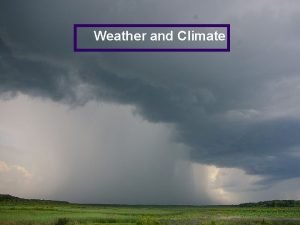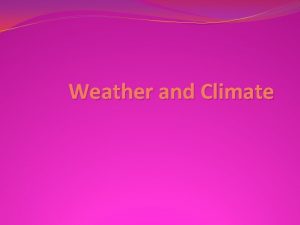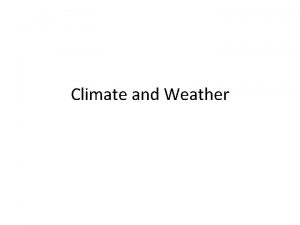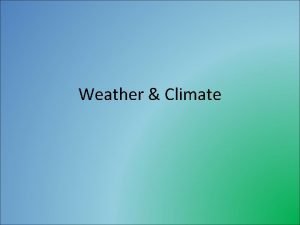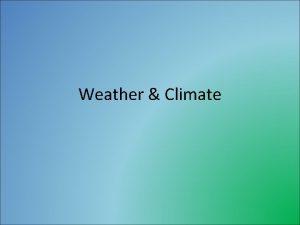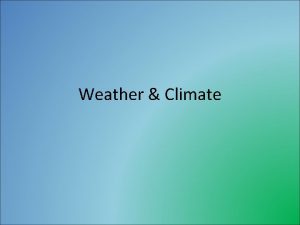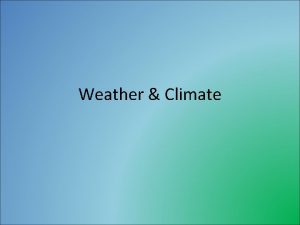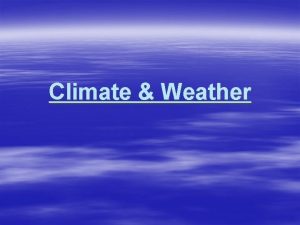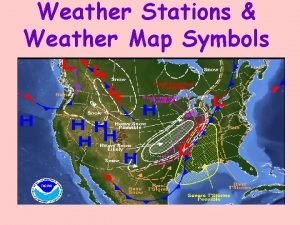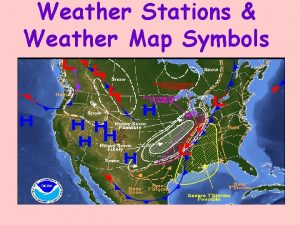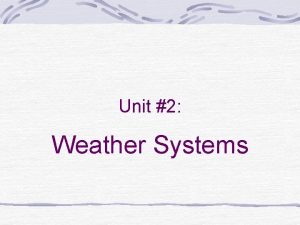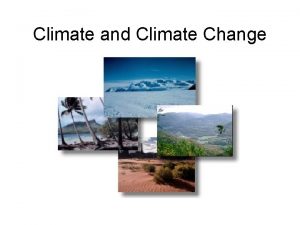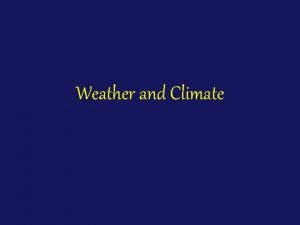Chapter 2 Climate Climate Map Weather and Climate



















- Slides: 19

Chapter 2 Climate

Climate Map

Weather and Climate • Weather refers to the unpredictable changes in air that take place over a Short period of time. Climate is the usual, predictable pattern of weather in an area over a long period of time. • Climate is affected by the sun, the wind, the oceans and other bodies water, landforms, and even people. • To understand an area’s climate, scientist look at extremes of temperature and precipitation.

The Sun and Climate The sun and climate • • • The original source of climate is the sun. Wind and water carry the sun’s heat around the globe. A place’s climate is also affected by its latitude. The sun’s rays hit the earth more directly at low latitudes. Places at low latitudes receive only angled rays of the sun. The areas near the Equator are known as the Tropics. They lie between the Tropic of Cancer (23 ½ N latitude) and the tropic of Capricorn (23 ½ S latitude). The Tropics experience a hot climate year-round.

The Wind’s Effect of Climate Movements of air are called winds. Winds follow typical pattern, affecting climate. Monsoons are powerful seasonal winds that blow over continents for months at a time. They are found mainly in Asia and some areas in Africa. Thunderstorms sometimes produce tornadoes, or funnel-shaped windstorms. Although they occur all over the world, the United States experiences more tornadoes than any other area.

Wind and Climate Violent tropical storms called hurricanes form over the warm waters of the Atlantic Ocean in late summer and early fall. Hurricanes usually strike the Caribbean islands and North America. When the same type of storm hits Asia, it is called a typhoon. A period of extended dryness is called a drought. El Niño—a unique combination of temperature, wind, and water effects in the Pacific Ocean--- last occurred in 2016. El Ninos occur about every 3 years and form when cold winds from the east are weak and the Pacific Ocean gets warmer than usual. When the opposite kind of unusual weather takes place, the event is known as La Nina.

Water Currents Ocean Currents • Moving Streams of water called currents carry warm or cool water through the world’s oceans. • These currents affect the climate of land areas. Winds that blow over warm currents, for example, carry warm air to land areas.

Landforms and Climate • The shape of land the location of landforms in relation to one another and to water also affect climate. • Local winds are patterns of wind cause by landforms in a particular area. Some winds occur because land warms and cools more quickly than water. As a result, cool sea breezes keep coastal areas cool during the day. After the sun sets, the land cools down, and cool breezes low out to sea.

Landforms and Climate • The higher the elevation a place has the cooler it will be. • As air moves up the windward side of mountain peaks, it becomes cool and loses its moisture. The air that crosses over the peaks is dry, creating a rain shadow. A rain shadow is a dry area on the leeward side of the mountains. The dry air of a rain shadow warms up again as it moves down mountainsides, giving the region a dry or desert climate.

Impact of People on Climate

People and climate • People’s actions affect climate. For example, cities are warmer than rural areas because streets and buildings absorb more heat than plants and trees do. In addition, people burn fuels, which raises temperatures. • In the past 200 year’s people have burned coal, oil, and natural gas as a source of energy. The buildup of the gases from the building of these substances has prevented warm air from rising and escaping into the atmosphere. This is known as the greenhouse effect, in which the earth’s temperature will increase.

Rain Forest • Dense forests that receive high amounts of rain each year are known as rain forests. People burn trees to clear rain forest, which leads to the greenhouse effect. Also, less water evaporates if there are fewer trees, decreasing rainfall.

The Climate Zones of the earth

Tropical Climates Tropical • • • There are two types of tropical climates------- tropical rain forest and tropical savanna. Areas with a tropical rain forest climate have year-round rains that produce lush vegetation and thick rain forest. Tall hardwood trees such as mahogany, teak, and ebony form a canopy, or top layer of the forest. tropical Savanna areas have a definite wet season, while the remainder of the year is hot and dry. Savannas, or broad grasslands with few trees, are found in these areas.

Mid-Latitude • Mid-latitude climates include more and different climates zones. This is due to a mix of air masses warm air from the Tropics and cool air from the polar regions. • The marine west coast climate occurs along coastal areas that receive winds from the ocean. Winters are rainy and summers are cool in these areas. Marine West Coast- San Diego • Marine west coast

Mid Latitude • The coastal Mediterranean climate also has rainy, mild winters. It differs from the marine west coast climate in that the Mediterranean climate experiences hot, dry summers. Shrubs and short trees grow in this climate. Mediterranean

Mid Latitude Mid latitude • The humid continental climate occurs in the inland areas of North America, Europe, and Asia. Winters can be long, cold, and snowy. Summers are short and may be very hot. Deciduous trees and vast grasslands grow here. Humid Continental

Mid Latitude • Mid-latitude regions close to the tropics experience a humid subtropical climate where rain falls throughout the year. Oak, Magnolia, and palm trees grow here. Humid Sub tropical

High Latitude • In the high latitudes nearest the mid-latitude zones, you will find the Tundra climate. Winters are severely cold and bitter. Huge evergreen forest called taiga grows here. • Closer to the Poles than the subarctic zone lie areas of vast rolling plains without tress. This region is known as the tundra and is harsh and dry. In these parts, much of the lower layers of soil stays permanently frozen and is known as Permafrost.
 World geography today
World geography today Weather climate and society
Weather climate and society How do prevailing winds affect climate
How do prevailing winds affect climate Cimates
Cimates Conclusion of weather and climate
Conclusion of weather and climate Climate zones and weather worksheet answer key
Climate zones and weather worksheet answer key Whats the difference between weather and climate
Whats the difference between weather and climate Objectives of weather and climate
Objectives of weather and climate Weather and climate crash course
Weather and climate crash course Crash course kids weather
Crash course kids weather Thunder is the sound of brainpop
Thunder is the sound of brainpop Weather and climate jeopardy
Weather and climate jeopardy Weather and climate interactive activities
Weather and climate interactive activities Tools to measure weather
Tools to measure weather Idioms about weather and climate
Idioms about weather and climate Poem of seasons
Poem of seasons Noaa toolkit
Noaa toolkit Explain how some hail can become baseball sized
Explain how some hail can become baseball sized What is the difference between weather and climate
What is the difference between weather and climate Weather and climate kahoot
Weather and climate kahoot

